#nakajima ki-84 hayate
Explore tagged Tumblr posts
Text
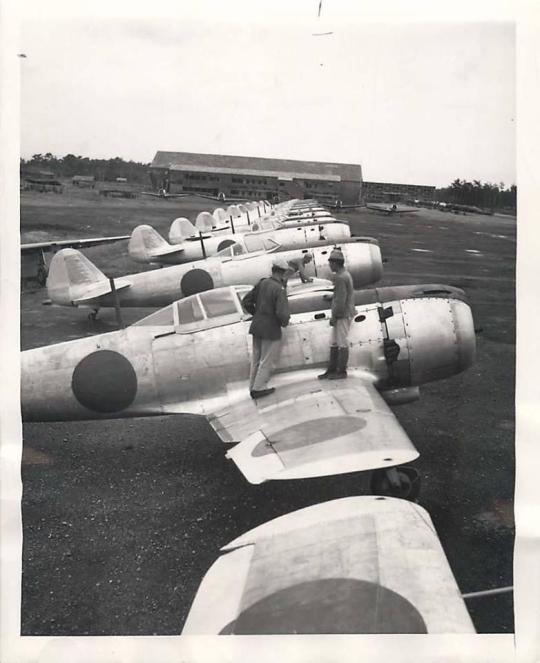
Chasseurs Nakajima Ki-84 Hayate démilitarisés et stockés après la capitulation du Japon – Base aérienne de Utsunomiya – Japon – 1945
#WWII#après-guerre#after war#capitulation du japon#surrender of japan#démilitarisation#demilitarization#armée de l'air impériale japonaise#imperial japanese army air service#ijaas#aviation militaire#military aviation#chasseur#avion de chasse#fighter#nakajima ki-84 hayate#ki-84 hayate#ki-84#utsunomiya#japon#japan#1945
62 notes
·
View notes
Photo
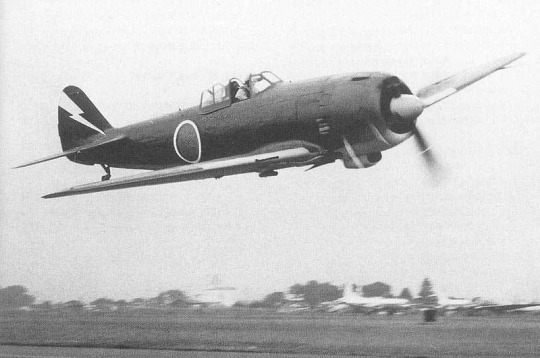
Nakajima Ki-84 Hayate fighter aircraft
First flown February 1943 , the Ki-84 was operated by the Imperial Japanese Army Air Service in the last two years of World War II. The Allied reporting name was "Frank"; the Japanese Army designation was Army Type 4 Fighter. It had a top speed of over 400 mph, it was the fastest fighter of it’s type used by the Japanese.
105 notes
·
View notes
Text
Amestris Military Real world Influence
This is the third of my series of long posts about the Amestrian Military. This is the post for the history nerds. There are plenty of real world references in Fullmetal Alchemist, especially pertaining to the first half of the 20th century. While Amestris and its military have often been compared to Nazi Germany (especially when it comes to the anime), the references in the manga are very diverse. Disclaimer, this is by no means an exhaustive list, there are too many for me to cover in one post, and I'm not a historian. So let me know if there's any reference I might have missed or if I got something wrong!
To see the rest of this meta series check out the Main Post..
Names
Probably the easiest reference to the real world is in the names of the military personnel. Almost all of them are named after military vehicles and equipment, mainly from World War II. Some examples:
Roy Mustang — P-51 Mustang (USA WW2 aircraft)
Riza Hawkeye & Grumman — Northrop Hawkeye E-2 Grumman (USA 60s aircraft)
Maes Hughes — Hughes aircraft series (USA aircraft company)
Black Hayate — Nakajima Ki-84 Hayate (Japanese WW2 aircraft)
Jean Havoc & Henry Douglas— Douglas A-20 Havoc (USA WW2 aircraft)
Heymans Breda — Breda M37 (Italy WW2 Machine gun) or HMS Breda (UK WW2 Yacht)
Kain Fuery — Hawker Fury (UK 30s aircraft)
Vato Falman — Farman aircrafts series (French aircraft company)
Armstrong Family — Armstrong Whitworth Whitley (UK WW2 aircraft)
Weapons and equipment
The weapons used by the military are also based on real world weaponry. Arakawa herself admitted to using references for weapons as well as for the vehicles.[1] Not all of them are a direct copy of a historical weapon, but all of them are at least inspired by one or more of them.
Pistol — Colt M1911A1 (USA 1924)
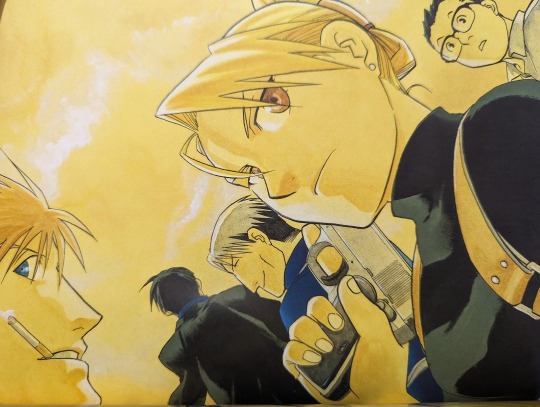
Hawkeye's pistol. [1]

Colt M1911 & M1911A
Rifle — Mauser Karabiner 98k (Germany WW2)

Hawkeye's Rifle. [1]
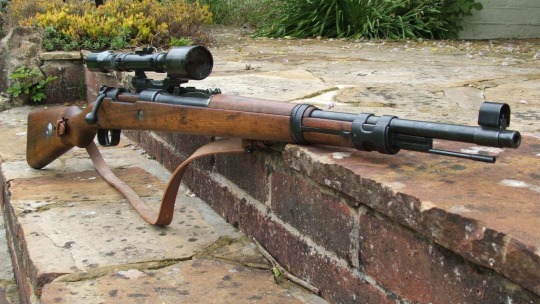
Mauser Karabiner 98k rifle
Hand grenade — Stielhandgranate M24 aka the potato mashers (Germany WW2)

Team Mustang's and their weapons. [1]

Stielhandgranate M24
Briggs' Tank
The Briggs' tank isn’t modeled directly after any specific tank, and rather takes inspiration from different WW1 to WW2 tanks. The manga and Brotherhood tanks take after different inspirations, with Brotherhood being more German coded than the manga tank. There's an excellent article in the tanks encyclopedia analyzing the Fullmetal Alchemist tanks if anyone's interested.
Military Cars —
We see a few military cars throughout the story. Once again the cars we see in the manga and Brotherhood are quite different, and they appear to be based on models from the late 1910s to the late 1930s.
The manga’s standard issued military car looks at least partially inspired by the American Ford model A of 1927.
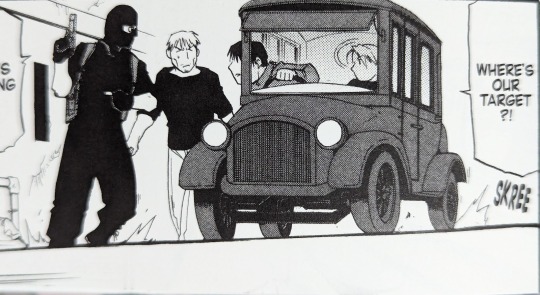
Mustang's military car(manga).[2]

1927 Ford model A.
The Brotherhood art sketches have two different drawings of military cars. The first one, the one we see Mustang use, is based on the French Citroën traction avant 11CV of 1935.

Fullmetal Alchemist Brotherhood military vehicle version 1.

1935 French Citroën traction avant 11CV.
The second car seems to be inspired by the Italian Fiat Tipo 5 of the 1910s. Perhaps even inspired by one of the American made Fiat models.
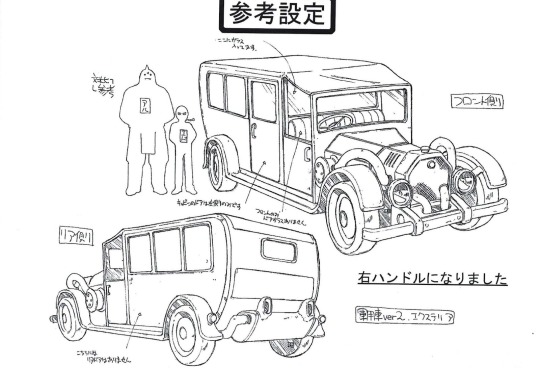
Fullmetal Alchemist Brotherhood military vehicle version 2.
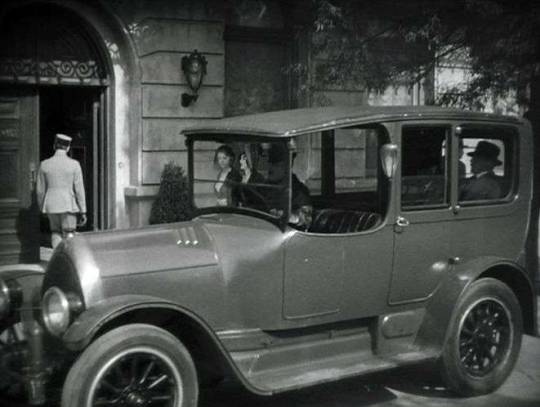
Fiat tipo 55.
Ranks and insignias
With the exception of the Führer-President, the Amestrian military ranks appear to be a mix of the USA WW2 officer ranks:
General,
Lt. General,
Major General,
Brigadier General,
Colonel,
Lt. Colonel,
Major,
Captain,
1st Lieutenant,
2nd lieutenant;
As well as the Imperial Japan NCO ranks:
Warrant officer (Special Sergeant Major),
Master Sergeant,
Sergeant,
Corporal.
The history of the Imperial Japan Warrant Officer rank is a bit confusing and complicated. In the 79 years that the Empire lasted, the Warrant Officer rank saw a lot of changes, being its own category at times, a Senior NCO at others. The NCO Warrant Officers seem to have been specialized Sergeant Majors (also translated as Master Sergeant) that basically functioned as the most senior of the NCO ranks. Aside from this the one modern country, I could find, that has Warrant Officers as NCO is Malaysia.
The rank of Führer-President (大総統 - Daisōtō in Japanese) replaces the rank of General of the army in the USA officer classification. While the English translation is a direct reference to Nazi Germany, the Japanese word is a lot more nuanced.
The word Daisōtō actually refers to the president of the 1912-1924 Republic of China, and if you Google it, all you will get is images of Bradley himself. The term used for “Führer” is 総統 (Sōtō), without the 大 (Dai) which is instead used in the word president 大統領 (Daitōryō), this is probably the inspiration for the Führer-president title of the official English translation.
However, Sōtō isn't used to refer just to Nazi Germany's Führer, but rather to any fascist associated head of state. As such Germany's Sōtō is the Fuhrer, but Italy's Sōtō is the Duce (Mussolini).
The effect is technically the same (you still think of Hitler and fascism), but the Japanese word is not a direct translation of Führer, nor a direct reference to Nazi Germany, it's more subtle than the English translation. I imagine Führer was used in English (in absence of a more subtle unifying word) as it is more recognizable to the English speaker than other fascist titles like: Duce, Caudillo, Generalísimo, etc.
The WW2 imperial Japan ranks also included superior private, first class private, and second class private, but they were their own class, called soldiers, below the NCO ranks, and were mainly composed of men serving their conscripted time. This might explain their absence in the Amestrian official ranks as Amestris doesn't seem to have conscription.
The rank insignias themselves are pretty much a copy of the imperial Japan ones.
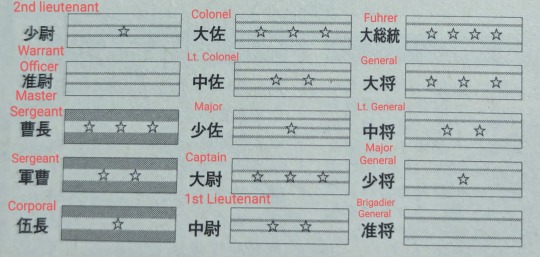
Amestris rank insignias.[3]
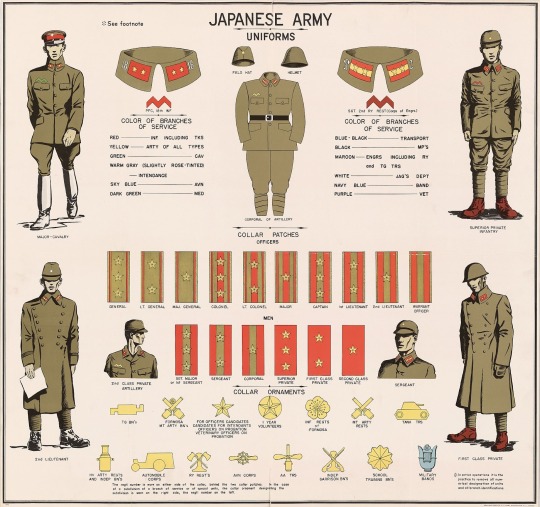
Imperial Japan ranks insignias.
Uniform
In terms of the uniform there's not one single reference or perfect match for the design, but the closest to it is probably the WW1 French infantry uniform.

Amestris military uniform. [1]
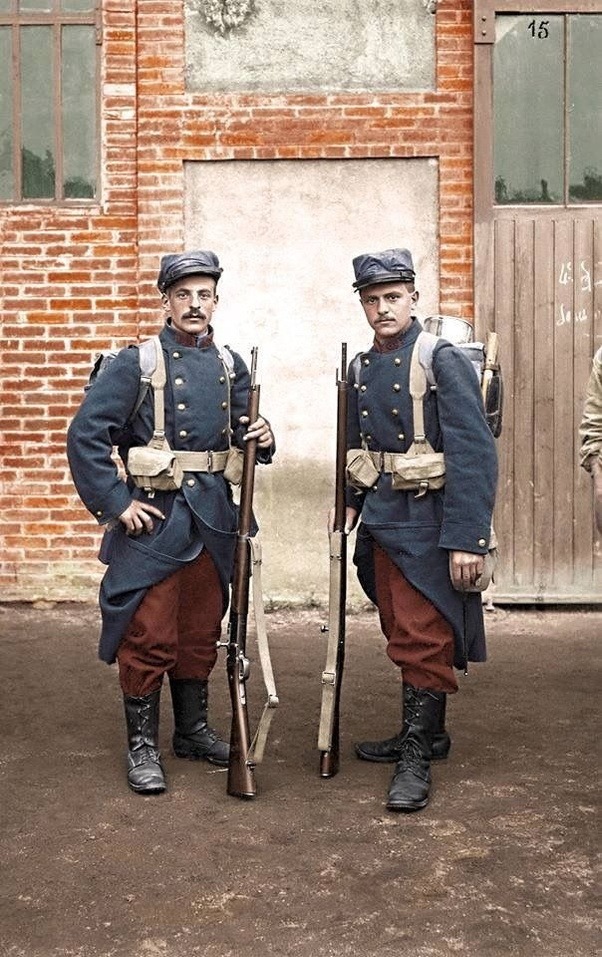
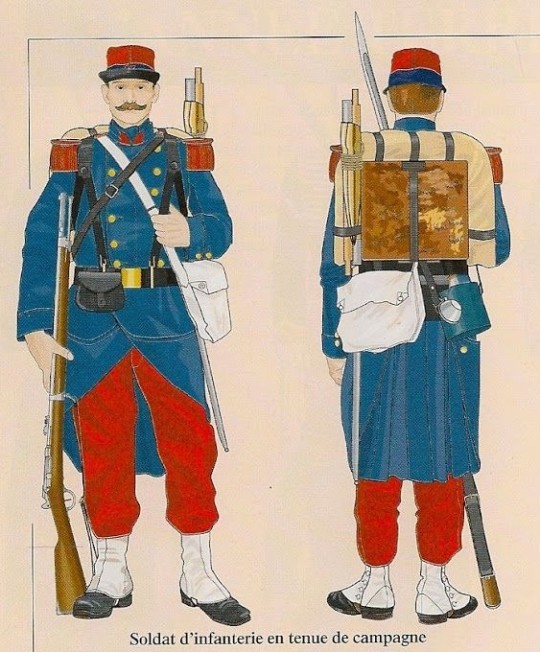
Early WW1 French uniform

Late WW1 French uniform
Aside from the color of the French uniform, the long skirt, flaps and boots are very similar to the Amestrian uniform.
The Amestrian short jacket itself seems to be inspired by the WW2 USA Ike jacket.

USA WW2 Ike jacket.
Furthermore the white lining of the Amestrian uniform reminds me of the Imperial Japan formal uniform jacket, which is itself Prussian and French inspired.
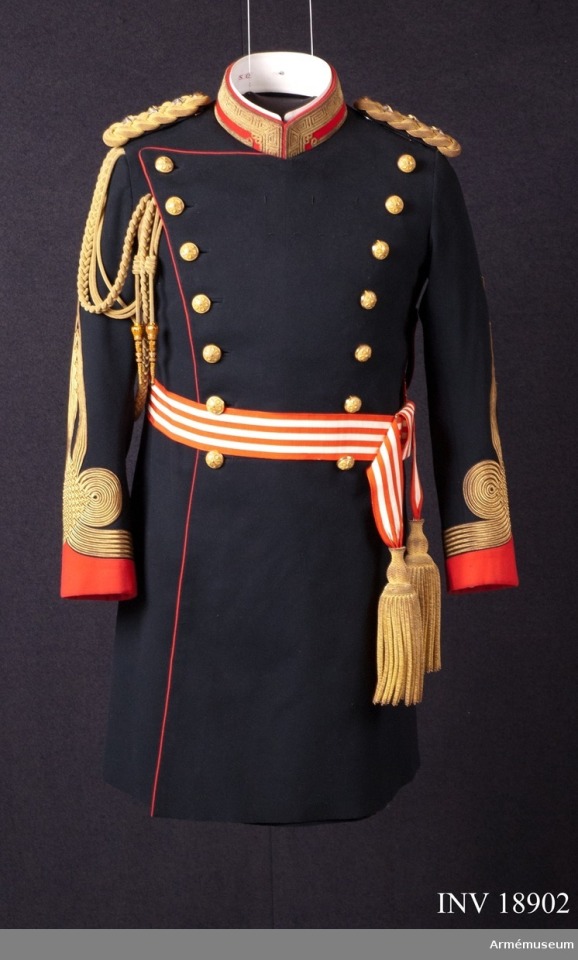
Imperial Japan Major General formal uniform.
The Briggs uniform is very much WWII winter gear inspired.
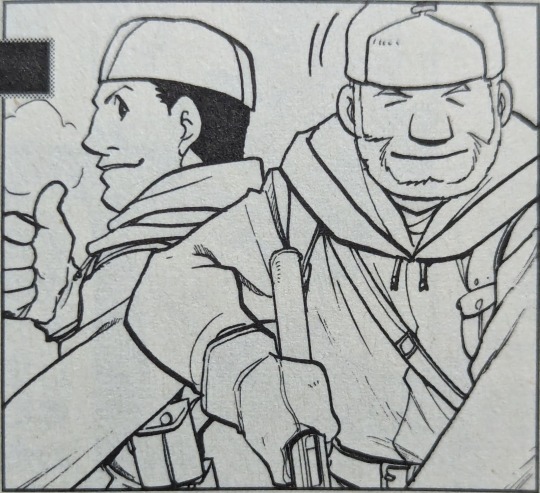
Briggs uniform.[3]
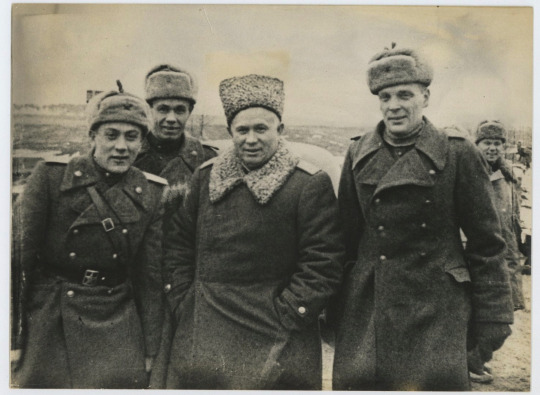
Soviet WW2 winter uniform

Finnish WWII sniper.
Out of every uniform variation, the one most German coded is, to no one's surprise, the Führer-president’s. His trench coat looks similar to the WW1 Prussian one.
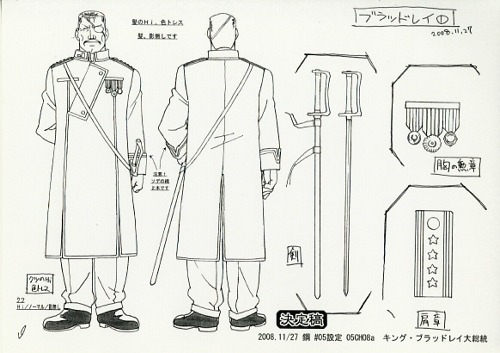
Bradley in uniform.

WW1 Prussian soldiers.
In general the uniform has a very World War I vibe to it, down to the impractical, decorative parts of it like the skirt. This is an uniform that obviously predates modern warfare, very apt for the time period the story is “set on”. This makes an interesting contrast with the weaponry which seem to be mostly World War II inspired.
Other references
Ishval war of extermination
First of all trigger warning for genocide and human experimentation. Just skip this section if you're sensible to these topics.
Just like the Ishvalan are an amalgamation of many cultures and ethnicity, the Ishvalan civil war seems to reference multiple conflicts and events.
Plenty of comparisons have been made with the Jewish genocide in the hands of the Nazi (and the 03 anime leans especially hard on this). There are also similarities with the Herero war and genocide at the hand of the German empire which just like the Ishval Civil war ended in 1908. Another possible reference is the Armenian genocide at the hands of the Ottoman empire, which also involved a minority living at the border of a nation the country was at war with and being suspected of colluding with the enemy. Both the Armenian and the Ishvalan soldiers serving in the army were dismissed, incarcerated, and eventually executed.
Another more clear cut reference made in the Ishval civil war is Mustang's and Knox’s experimentation. This would be a reference to the horrendous experiments done by both the Nazi and Japan's infamous unit 731. Both which included burning people to test treatments and the limits of the human body.
I am sorry to end up on such a hard note, but I think it's best we move on to other — less traumatic — topics.
Source
Fullmetal Alchemist Manga
Chapter 38: a counter attack signal [2]
The Complete art of Fullmetal Alchemist [1]
Fullmetal Alchemist perfect guide 3 [3]
Training Regime post
39 notes
·
View notes
Text
#poll#gender poll#full disclosure: i did NOT find out about the j7w shinden from the recent godzilla movie.#i knew the aircraft WAY before that
3 notes
·
View notes
Text

1944 Nakajima Ki 84-I Type 4 Hayate 22 Sentai - Shigeo Koike
29 notes
·
View notes
Text

Nakajima Ki-84
四式戦闘機, Yon-shiki sentō-ki (Type 4 Fighter)
疾風 ‘Hayate’ (Gale)


0 notes
Text
If you read Fullmetal Alchemist in Japanese, the characters refer to Black Hayate as ブラックハヤテ号 (black hayate-gou).

The word on the end, 号 (gou) means "number; edition; make; model; issue; part of that group", and it's usually used as a numbering suffixー like 号室 (goushi-tsu) after a hotel room or apartment number, and 号車 (gousu-u) for train car numbers.
But another use for gou is as a suffix attached to names of ships, trains, and airplanes. If you ever played the first couple of Pokemon games, you probably had to get aboard the サント・アンヌ号 (santo annu-gou) or the "S.S Anne":

For the English release, gou was translated as the boat prefix "S.S".
But why would Hayate have a suffix on his name that's meant for boats, trains and planes? Because he is named after the Nakajima Ki-84 Hayate (疾風), a fighter jet flown by the Imperial Japanese Army Air Service in World War II. The plane's name means "gale" or "strong wind."

There isn't really a prefix for airplanes in English the same way we have "S.S" or "R.M.S", so this detail was omitted in the English translation. The closest you'd really get are the P (pursuit) and F (fighter) designations used by the US Air Force (like the F-35 fighter jet, for example) but "F-84 Hayate" isn't that much better, either.
That's why Hayate has 'gou' on the end of his name - the characters are literally nicknaming him the "S.S Hayate".
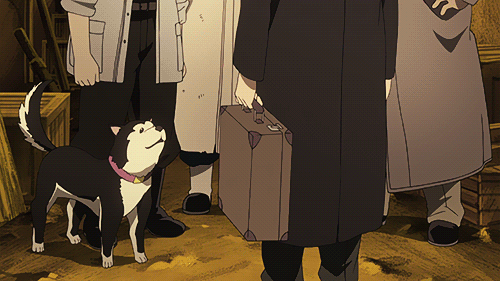
Most of the Amestrian soldiers in Fullmetal Alchemist are named after some kind of military plane or vehicle. Here's the North American P-52 Mustang:

The Northrop Grumman E-2 Hawkeye:

The Armstrong Whitworth Whitley bomber:
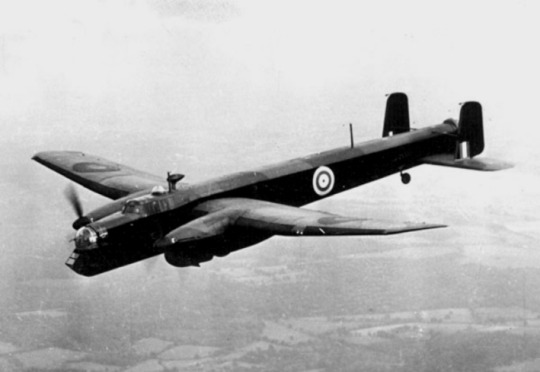
And the Bradley Fighting Vehicle (yes, it's a tank.)

(Thanks for everyone that's been reading and responding to these explanation posts so far! If there's anything I should include or correct, please let me know).
738 notes
·
View notes
Text

wcbohannon Following
97-C5-11 1960 Nakajima KI-84 Hayate
16 notes
·
View notes
Text

• Nakajima Ki-43 Hayabusa
The Nakajima Ki-43 Hayabusa (隼, "Peregrine Falcon" was a single-engine land based tactical fighter used by the Imperial Japanese Army Air Force in World War II.
The Ki-43 was designed by Hideo Itokawa, who would later become famous as a pioneer of Japanese rocketry. The Ki-43 prototype was produced in response to a December 1937 specification for a successor to the popular fixed-gear Nakajima Ki-27 Nate. The specification called for a top speed of 500 km/h (311 mph), a climb rate of 5,000 m (16,400 ft) in five minutes and a range of 800 km (500 mi). Maneuverability was to be at least as good as that of the Ki-27. When first flown in early January 1939, the Ki-43 prototype was a disappointment. Japanese test pilots complained that it was less maneuverable than the Ki-27 Nate and not much faster. In order to solve these problems, Nakajima produced a series of progressively modified prototypes through 1939 and 1940. These changes involved a major weight saving program, a slimmer fuselage with the tail surfaces moved further aft and a new canopy.
Crucially, the 11th prototype introduced the unique differential "butterfly" maneuvering Fowler flaps, which dramatically improved performance in tight turns. The 13th prototype combined all these changes, and tests of this aircraft resulted in an instruction for Nakajima to place the Ki-43 into production, the Ki-27 jigs being transferred to the Mansyu factory at Harbin in Japanese occupied Manchukuo. The Ki-43 (Oscar) was initially produced in November 1939, given the designation Ki-43-I. Deliveries from Nakajima's Ota factory commenced in February 1941. In addition to outstanding maneuverability, the Ki-43-I had an impressive rate of climb due to its light weight. Power was provided by the Nakajima Ha-25 engine turning a two-bladed, two-position variable-pitch metal propeller. The Ki-43 was equipped with two synchronized cowling machine guns in various configurations, with either two 7.7 mm (.303 in) Type 89 machine guns, one 12.7 mm (.50 in) Ho-103 machine gun and one 7.7 mm (.303 in) gun, or two 12.7 mm (.50 in) Ho-103 guns; the aircraft was given various sub-designations to reflect these differences.
Prototypes for the Ki-43-II flew in February 1942. The Ha-25 engine was upgraded with the 2-stage supercharger, thus becoming the more powerful Nakajima Ha-115 engine, which was installed in a longer-chord cowling. The new engine turned a three-bladed propeller. The wing structure, which had suffered failures in the Ki-43-I, was strengthened and equipped with racks for drop tanks or bombs. The Ki-43-II was also fitted with a 13 mm armor plate for the pilot's head and back, and the aircraft's fuel tanks were coated in rubber to form a crude self-sealing tank. This was later replaced by a 3-layer rubber bladder, 8mm core construction; with 2mm oil-proof lamination. The pilot also enjoyed a slightly taller canopy and a reflector gunsight in place of the earlier telescopic gunsight. Nakajima commenced production of the Ki-43-II at its Ota factory in November 1942.
The Ki-43 was the most widely used Army fighter, and equipped 30 sentai FR,(flight regiment) and 12 chutais IS,(independent squadrons). The first unit equipped with the Ki 43-I was the 59th FR at Hankow Airfield, during June–August 1941 and began operational sorties over Hengyang on October 29th, 1941. The second unit to re-equip with the new Aircraft was the 64th FR, from August to November 1941. The first version, Ki-43-I, entered service in 1941, the Ki-43-II in December 1942, the Ki-43-II-Kai in June 1943, and the Ki-43-IIIa in summer 1944. The aircraft fought in China, Burma, the Malay Peninsula, New Guinea, the Philippines, South Pacific islands and the Japanese home islands. Like the Zero, the Ki-43 initially enjoyed air superiority in the skies of Malaya, Netherlands East Indies, Burma and New Guinea. This was partly due to the better performance of the Oscar and partly due to the relatively small numbers of combat-ready Allied fighters, mostly the Curtiss P-36 Hawk, Curtiss P-40, Brewster Buffalo, Hawker Hurricane and Curtiss-Wright CW-21 in Asia and the Pacific during the first months of the war.
As the war progressed, however, the fighter suffered from the same weaknesses as the slower, fixed-gear Ki-27 "Nate" predecessor to the Oscar, and the more advanced naval A6M Zero; light armor and less-than-effective self-sealing fuel tanks, which caused high casualties in combat. Its armament of two machine guns also proved inadequate against the more heavily armored Allied aircraft. As newer Allied aircraft were introduced, such as the Republic P-47 Thunderbolt, Lockheed P-38 Lightning, North American P-51 Mustang. The Japanese were forced into a defensive war and most aircraft were flown by inexperienced pilots. However, even near the end, the Oscar's excellent maneuverability could still gain advantage over rash Allied pilots. Like most Japanese combat types, many Hayabusas were at the end expended in kamikaze strikes.
The Ki-43 also served in an air defense role over Formosa, Okinawa and the Japanese home islands. Some examples were supplied to the pro-Japanese regimes of Thailand, Manchukuo and Wang Jingwei Government as well. The Thai units sometimes fought against the USAAF in southern China. Hayabusas were well liked in the JAAF because of the pleasant flight characteristics and excellent maneuverability, and almost all JAAF fighter aces claimed victories with Hayabusa in some part of their career. At the end of the war, most Hayabusa units received Ki-84 Hayate "Frank" fighters, but some units flew the Hayabusa to the end of the war. The top-scoring Hayabusa pilot was Sergeant Satoshi Anabuki with 39 confirmed victories, almost all scored with the Ki-43.
After the war, some captured examples served in limited numbers in the French Air Force in Indochina against Viet Minh rebels. Ki-43s abandoned in the Netherlands East Indies were taken over by the newly declared Indonesian government and put into service during the fight against Dutch forces. Over the course of the war 5,819 Ki-43-I, Ki-43-II and Ki-43-IIIa builds were produced. Several surviving examples are a Ki-43-I on display at Flying Heritage Collection in Everett, Washington, a Ki-43-II displayed unrestored at the Australian War Museum in Canberra, Australian Capital Territory. Ki-43 originally under restoration/rebuild at Texas Airplane Factory, Meacham Field, Fort Worth, Texas, and a Ki-43 awaiting restoration at The Fighter Collection in Duxford, United Kingdom.
#second world war#world war 2#japanese history#imperial japan#japan#ww2#wwii#aviation#japanese air force#military aircraft#military history
45 notes
·
View notes
Note
((Not on anon because reasons: What led to Shoki's creation? Were there any influences you drew from, or did he just appear one day?))
This was about ten years ago when I rped JKMM/Mitternacht Marine, a story much like hetalia that had personified war machines from World War 2. At the time, before making him, I had a very successful OC in the group I rped in on Gaia Online. His name was Emil, and based off of the Boeing B-17 Heavy Bomber. Being someone who has loved planes and flying since I was a really really little kid, I was very much into learning and making characters based off these planes.
One of my very best friends Annie rped the canon character’s female counterpart for the Nakajima Ki-43 Hayabusa (while our friend Jojo DID rp the canon character named Hayabusa), and I’d wanted to make a “little brother” for the two. I looked up online the next two predecessors to the Hayabusa, and found the Nakajima Ki-44 Shoki and Nakajima Ki-84 Hayate. After doing more research, I felt like the Ki-44 would be something I wanted to try translating into a character, and in my research I found out that the pilots flying the planes had a really hard time seeing out of the windows and it often led to crashes. That was the original inspitation for him being blind.
As one would suspect, it isn’t easy translating that into a fandom like Pokemon, and many of what he is today is because of my friends @sterlingsilverchampion, @fabulance, and @puppygrunt. Four years ago many of us in our own little discord had ocs, I was one of the ones that didn’t because I was wary about making one. I remember wanting to bring Emil here, but I could never find a face claim I liked, and instead I found one that absolutely fit my idea for Shoki- and finding a psd that made it hard for you to see his eyes made it that much better. But I could never find a reason for him. Why did I want to rp him? Would people like him?
It was in a call with these three that I started to talk about these questions I had, and those three in particular really helped me get him off the ground. I think it was Sir that suggested that he was blind, but could see or feel aura and that it helped him get around a little easier. As for the fighting mono type team, I got that inspiration after someone at work had said that mono teams were “lame” and fighting especially was the weakest. So I did it to prove him wrong, which I got to do in skull brawl lmao. So he didn’t just appear one day, it’s been a long time in the making.
A lot of my inspiration also comes from Iggy from Maximum Ride; A blind human bird hybrid who was the snarkiest and the most tech savvy kid in the group, Matt Murdock from Marvel’s Daredevil; a blind lawyer turned super hero, and Toph from Avatar: The Last Airbender- who I’m sure most people know is the blind sarcastic and snarky earth bender who befriends Aang, Katara, and Sokka.
3 notes
·
View notes
Photo








Nakajima KI-84 Hayate “Frank”
Tamiya 1/48
#model kit#1/48 model kit#scale modeling#mode;arstwo lotnicze#modelarstwo plastikowe#scalemodel#sca;e model kit#miniatures#scale miniatures#scale aircraft#miniature world
7 notes
·
View notes
Photo
Hayate is also named after a WW2 era fighter the Nakajima Ki-84. And Fuhrer Bradley a tank






Team Mustang name origins
4K notes
·
View notes
Text
PEQUEÑAS HISTORIAS DE LAS GRANDES GUERRAS
El Último As en un día tenía sangre Mexicana
464th Fighter Squadron
USAAF Fuerza Aérea Norteamericana
Segunda guerra mundial (1945)
Un As del aire se refiere a aquel piloto que en combate ha derribado a 5 o más aeronaves y regresado para contarlo, por lo tanto para recibir el título de As en un día se tenía que derribar al menos 5 aeronaves enemigas en el mismo día y sobrevivir.
Oscar Francisco Perdomo nació el 14 de junio de 1919, en El Paso, Tejas, hijo de veteranos de la Revolución Mexicana, su padre fue uno de los dorados de Villa.
Con la Gran Guerra en su apogeo, Perdomo decidió iniciar su carrera aeronáutica en la escuela de aviación ubicada en Chandler, Arizona, donde obtendría sus alas en enero de 1944, posteriormente sería trasladado a la escuela de Chico, California, donde se especializados en la aeronave Republic P-47 Thunderbolt, ahí sería asignado al 464th escuadrón de combate, que formaba parte del 507th Grupo de Combate, el cual fue desplegado al pacifico.
Estacionados en la isla de Le Shima, su principal función era escoltar a los bombarderos la cual iniciaría el 1ro de Julio de 1945. Abordo de su P-47 Thunderbolt apodado "Lil Meaties Meat Chopper", Perdomo, brindaría apoyo al 8th escuadrón de bombardeo, en las operaciones en la isla de Kyushu.
Siendo el 13 agosto de 1945, El teniente de ala Óscar Perdomo voló la misión que lo convertiría en "as en un día".
Fue enviado junto con su grupo a patrullar en los alrededores de Keijo (ahora Seúl, Corea del Sur), cuando repentinamente se encontrarían con un grupo aproximado de 50 aeronaves enemigas, por lo que entablará combate, derribando 3 Nakajimas Ki-84 Hayate
Posteriormente al salirse accidentalmente de la formación se encontró con dos biplanos Yokosuka Tipo 93 K5Y, de los cuales derribó uno. Finalmente, al regresar a formacion derribó otro Ki-84, convirtiéndose de esta forma en "As en un día". Y el último as de la segunda guerra mundial.
Está fue la última misión de Perdomo en el frente de la segunda guerra mundial. Por sus acciones recibiría la medalla del aire y la medalla de servicio distinguido.
Después de la guerra continuo en servicio activo y en 1950 fue llamado nuevamente cuando la Guerra de Korea estalló, participó en. Ella y se retiró del ejército en 1958 con el grado de Mayor.
Para 1970 desarrollaría una fuerte adicción y dependencia al alcohol después de conocer que su hijo había fallecido durante operaciones de combate en Vietnam, y lo acompañaría en Marzo 02 de 1976, debido a una falla hepática.

0 notes
Text

1945 02 Nakajima Ki-84 Type 4 Hayate 'Frank' 47 Sentai -Takayoshi Wada
23 notes
·
View notes
Photo

Nakajima ki-84 Type 4 “Hayate”
Imperial Japanese Army Type 4 Fighter Hayate
中島飛行機 キ-84 四式戦闘機 疾風
8 notes
·
View notes
